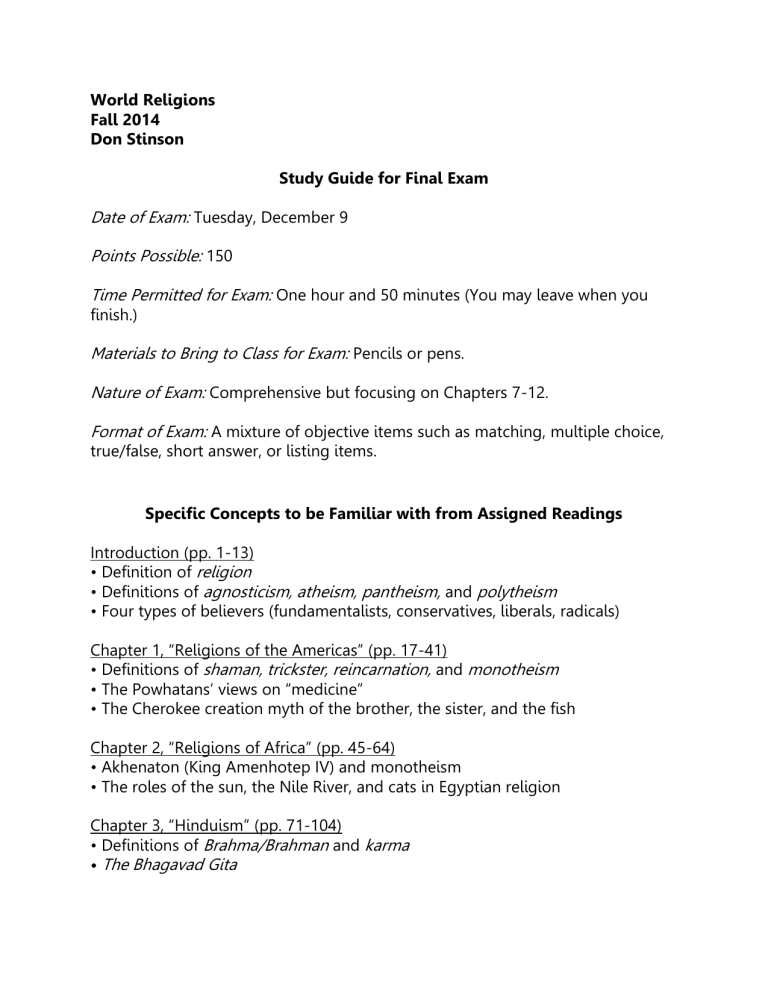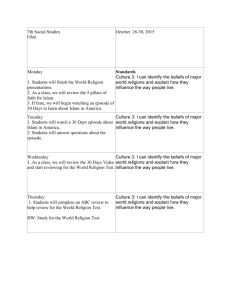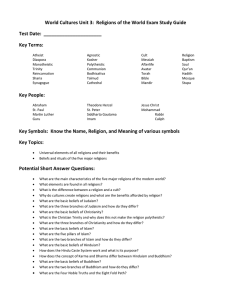
World Religions Fall 2014 Don Stinson Study Guide for Final Exam Date of Exam: Tuesday, December 9 Points Possible: 150 Time Permitted for Exam: One hour and 50 minutes (You may leave when you finish.) Materials to Bring to Class for Exam: Pencils or pens. Nature of Exam: Comprehensive but focusing on Chapters 7-12. Format of Exam: A mixture of objective items such as matching, multiple choice, true/false, short answer, or listing items. Specific Concepts to be Familiar with from Assigned Readings Introduction (pp. 1-13) • Definition of religion • Definitions of agnosticism, atheism, pantheism, and polytheism • Four types of believers (fundamentalists, conservatives, liberals, radicals) Chapter 1, “Religions of the Americas” (pp. 17-41) • Definitions of shaman, trickster, reincarnation, and monotheism • The Powhatans’ views on “medicine” • The Cherokee creation myth of the brother, the sister, and the fish Chapter 2, “Religions of Africa” (pp. 45-64) • Akhenaton (King Amenhotep IV) and monotheism • The roles of the sun, the Nile River, and cats in Egyptian religion Chapter 3, “Hinduism” (pp. 71-104) • Definitions of Brahma/Brahman and karma • The Bhagavad Gita Chapter 4, “Buddhism” (pp. 109-146) • Definitions of dharma, Nirvana, and mantra • The basic life of Siddhartha Gautama, the Buddha • The Four Noble Truths • The Eightfold Path • The Theravadins and the Mahayanists Chapter 5, “Jainism and Sikhism” (pp. 151-172) • Jainism’s basic beliefs (see page 156 in particular) • Sikhism’s relationship to Hinduism and Islam Chapter 6, “China and Japan” (pp. 177-213) • The concepts of Yang and Yin • Definition of Dao (Tao) • Basic themes of the Dao De Jing • Relationship between Shinto and Buddhism in Japan Chapter 7, “Ancient Religions of Iraq and Iran” (pp. 221-239) • The basic historical development of Mesopotamian civilizations (see especially pp. 222-4). • The myth of Dumuzi (Tammuz) and Inanna (Ishtar) (See pp. 224-5.) • The Epic of Gilgamesh • The life of Zarathustra • Basic teachings of Zoroastrianism (pp. 231-2) Chapter 8, “Judaism” (pp. 245-284) • Definitions of Torah, covenant, Passover, prophet, rabbi, Hanukkah, Messiah, diaspora, Kabbalah, and kosher • The stories of Abraham, Moses, the kings, and the Hebrew prophets (pp. 24855). • The main types of Judaism found in the U.S. today: reform, conservative, Orthodox, and Hasidic. Chapter 9, “Christianity” (pp. 289-331) • Definitions of parable, gospels, epistles, sacraments, ecumenical, Trinity, excommunicate, theology, indulgences, and incarnation. • The life and basic teachings of Jesus. • The roles of Peter and Paul in the early Christian movement (“the Way”). • Roman Emperor Constantine’s importance in Christian history. • The Greek and Latin traditions and their evolution into the Catholic and Orthodox Churches. • The Crusades • The Protestant Reformation and the various denominations and groups that evolved from the movement (see “A Christian Family Tree”). • The Church of Jesus Christ of Latter-Day Saints • Liberalism and fundamentalism within Christianity Chapter 10, “Islam” (pp. 335-372) • Definitions of Qur’an, Hajj, Shari’a, and jihad. • The life of Muhammad • The Five Pillars of Islam • Sunnis, Shi’as, and Sufis • Muslims’ relations with Jews and Christians • The Crusades • The Nation of Islam and the American Muslim Mission Chapter 11, “New Forms of Older Religions” (pp. 377-391) • Definition of eight-fold calendar • The history and basic beliefs of Baha’i. • The history and basic beliefs of the Church of Scientology. • The history and basic beliefs of the Druids. • The history and basic beliefs of Vodun. • The history and basic beliefs of Rastafarians. • The history and basic beliefs of the Wicca movement. Chapter 12, “Globalization and World Religions” (pp. 395-409) • Relationships between science and religion. • Gender relationships (feminism, gay rights, etc.) and religion. • The environment and religion. • Violence and religion.



